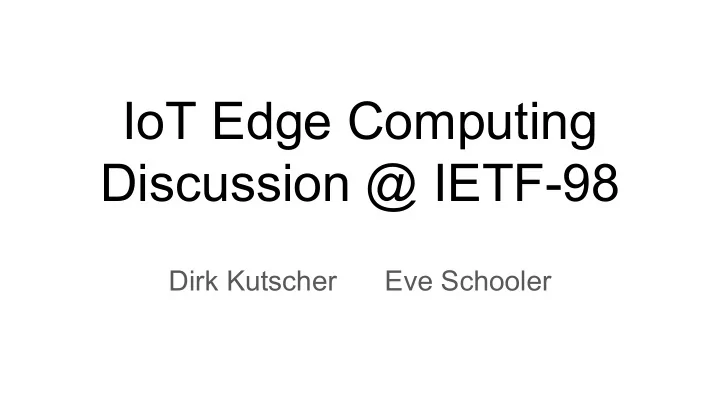

IoT Edge Computing Discussion @ IETF-98 Dirk Kutscher Eve Schooler
IoT Edge Computing Discussion ● Motivation for Edge Computing ● Terminology ● Research Questions ● Discussion https://github.com/t2trg/2017-ietf98/blob/master/slides/T2TRGEdgeComputing.pdf
Motivation for IoT Edge Computing When the IoT Data generated is: ● Delay-sensitive ● High-volume ● Trust-sensitive ● (Intermittently) disconnected ● Energy-challenged ● Costly to transmit
Terminology ● What is the edge ? ○ What is the edge a boundary between? ○ Edge is 1st step to Fog computing (a multi-tiered cloud of clouds) creating multiple edges ● Edge computing a step toward the DC re-imagined ○ Moves data center out of confines of back-end cloud ○ Moves cloud functionality closer to network Edge & Things ○ Distributes compute, storage, networking, control, actuation etc. ● Edge dynamics supports (mobile) edge computing ○ How dynamically can edges be created? ○ How dynamically do we need to distribute computation, storage, etc.? ● Edge computing is more than computation on a gateway ○ Often equated with first-hop gateway in the direction from Things to Cloud ○ An ensemble of resources willing to logically form an“edge cloud” ○ Not limited to specific platforms and execution environments
Research Questions (1/2) ● Programming models ○ How would people develop applications that can leverage edge computing? ○ What distributed constructs require support? ○ How to steward, curate, route, cache, process, migrate, archive the edge device data? ● Networking and operations ○ Compute function description & discovery ○ Assembly of individual functions into larger blocks, applications & services ○ Orchestration of edge computing systems ○ Managed vs. unmanaged edge computing
Research Questions (2/2) ● Isolation ○ How would individual tenants and compute functions be isolated in a decentralized cloud environment? ● What would be granularity levels for edge compute functions? ○ Containers ○ Step functions ○ Stateless functions ○ Named Function Networking as in ICN ● Multi-X ○ Multi-application, multi-user, multi-tenancy ○ Edge Computing in multi domain networks
Discussion (1/2) ● Difference between Edge Computing and Data Center Computing ○ New abstractions and mechanisms for edge computing? ○ Re-use existing cloud service provider APIs? ● Usability of Edge Computing ○ How to extend existing eco-system components (e.g., data/meta-data registries) to support? ■ due to increased levels of dynamics, scalability, and group data sharing ○ How to make distributed system interfaces intuitive and consistent? ● From “Pet” to “Cattle model” ○ In the presence of ubiquitous, cheap IoT deployments, how carefully should/can Edge Computing deployments be crafted? ○ What are the security and availability implications?
Discussion (2/2) ● “Rackscale for Edge Computing” ○ Will there be established models for disaggregating network, storage, compute? ○ Rely on similar automation and operations support functions (infrastructure management, telemetry)? ○ Rely on SDN standards to dynamically configure and reconfigure resource pools? ● Networking Edge Computing ○ What comms models best support Edge Computing? ○ How will Edge Computing affect existing protocols? ○ If edge and cloud represent two ends of the spectrum, how to seamlessly evolve toward fog computing? ○ Do/should intra-cloud and inter-cloud communication differ in Edge/Fog computing? ○ Are different technologies needed to support upstream vs downstream data flows?
Other Activities in the Meantime ● IRTF Distributed Internet Infrastructure ○ Decentralizing Internet infrastructure (for IoT, edge computing and other use cases) ○ https://trac.ietf.org/trac/irtf/wiki/blockchain-federation ● Information-Centric Fog Computing Workshop (next slide) ○ Might Information-Centric concepts be helpful (cf. Named Function Networking)? ○ Since ICNs already combine routing with native caching in the network, could they be extended to support processing for data in-flight as well (e.g., at the aggregation points in the reverse data flow paths)?
1st workshop on Information-Centric Fog Computing Dirk Kutscher Yiannis Psaras 12 June 2017 http://networking.ifip.org/2017/index.php/workshops/workshop-on-in formation-centric-fog-computing-icfc/icfc-technical-program
Schedule Overview Keynote: “Information-Centric Networking in Wireless Edge Networks and Beyond” -- Eve Schooler Session 1: Information Centric Networking and IoT ● “Edge-ICN and its application to the Internet of Things” , Nikos Fotiou, Vasilios A. Siris, George Xylomenos, George C. Polyzos, George Petropoulos, Konstantinos V. Katsaros ● “Observing Resources over ICN ”, H. Islam, Dmitrij Lagutin, Nikos Fotiou Session 2: Computing and Caching at the Edge ● “Execution State Management in Named Function Networking ”, Christopher Scherb, Balázs Faludi, Christian F Tschudin ● “In-Network Live Stream Processing with Named Functions ”, Christopher Scherb, Claudio Marxer, Urs Schnurrenberger, Christian F Tschudin ● “A Content-based Centrality Metric for Collaborative Caching in Information-Centric Fogs”, Junaid A Khan, Cedric Westphal, Yacine Ghamri-Doudane Industry Panel: Adoption Challenges and Prospects of Information-Centric Fog Computing Session 3: Computing Networks ● Invited Talk: “Tools, reliability and pricing for cloud-based compute instances”; Ioannis Andreopoulos ● “Benchmarking and Simulating the Fundamental Scaling Behaviors of a MapReduce Engine” , Brenton Walker ● “Session Support for SCN” , Mikael Gasparyan; Guillaume Corsini; Torsten Braun; Eryk Jerzy Schiller; Jonnahtan Eduardo Saltarin de Arco
Suggested Next Steps ● Opportunity to rethink IoT edge computing to support local, decentralized operation better ○ Removing dependency on cloud, edge gateways etc. ○ Light-weight function execution, enabling formation of local edge computing clouds ● This could be documented in a draft ○ Shortcomings with legacy edge computing approaches ○ Concepts for Thing-to-Thing edge computing ○ Research challenges
Recommend
More recommend